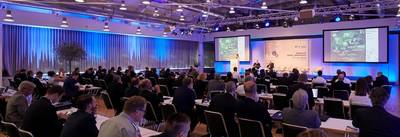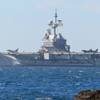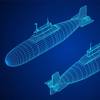New Strategies to Guard Against Future Security Threats
The international conference on maritime security and defense (MS&D), held for the seventh time in Hamburg during the SMM maritime trade fair, focused on current and future challenges to maritime security and defense. Twenty naval, industrial and science experts discussed topics such as how to protect international ocean trading routes, when and how to deploy naval forces on crisis missions, as well as cyber security issues.
The welcome address opened the event with somber words as Rear Admiral Thorsten Kähler, Chief of Staff of the German Naval Command based in Rostock, deplored the loss of appreciation for the United Nations and the fact that the organization’s efforts are often being undermined. Instead of the world’s nations treating each other with mutual respect, he said, a situation had arisen in which occupying foreign territories for the purpose of expanding one’s sphere of influence was getting the upper hand. His warning words were: “We are all in the same boat. The freedom of the oceans is a precondition for positive economic and social development in all countries.”
The new dangers of multi-dimensional warfare are threatening this freedom. But the German navy is responding, says Kähler. In what represents a paradigm change, operations are now smaller and more focused. Notwithstanding ongoing engagements in international missions, the importance of protecting the domestic borders is increasing, for example, by taking responsibility for the immediate neighbors along the Baltic Sea coast. At the same time, Kähler warned, new types of threats have arisen, such as cyber warfare. The rear admiral expressed his strong support for strategic cooperation, demanding more investments in personnel and equipment. The Bundeswehr white paper 2016 provides a solid basis for such efforts, he stressed.
China’s naval advance
Dr. Sarah Kirchberger’s speech showed how different the world can look from a different angle: The China expert, who teaches at the University of Kiel, pointed out that maintaining the stability of the country’s political system and its territorial sovereignty are the main motives of Chinese activities. "From the country's own perspective, this legitimizes the use of whatever means are deemed appropriate," said Dr. Kirchberger. What has prompted the recent vigorous development of the Chinese naval forces is a constant fear of the West which is rooted in the country's ideology, the head of the department ‘Strategic Developments in Asia-Pacific’ added. Her lecture portrayed the rapid growth of the Chinese Navy. Not only the quantity of naval ships is steadily increasing but their quality, as well. While China had often resorted to Russian material in the past, the country's industry was now capable of matching European standards. A new submarine fleet is adding nuclear naval deterrent capabilities, and new naval bases are being created by building artificial islands on reefs. Kirchberger closed by mentioning the potential of China collaborating with Russia, a constellation still underestimated by the West.
New conflicts caused by climate change
A challenge of an entirely different nature is climate change, one that has far-reaching implications for navies. Dr. Christian Webersik, who teaches Development Studies at the University of Agder, Norway, presented numerous statistics to demonstrate that there is in fact a connection between the increasing frequency and force of severe weather, and armed conflicts. As an example of a potential future conflict scenario he mentioned the current changes in Arctic ice cover which might lead to new border disputes. The thought was taken up by Dr. Patricia Schneider from the Institute for Peace and Security Policy Research at the University of Hamburg. The lack of a regulatory framework for the Arctic, and territorial claims raised by various nations could soon amount to a significant problem. As melting ice opens up new sea routes, those routes will be open to tourism, as well, which will require protection. New naval vessels will have to be designed to operate in these sea region, Dr. Schneider concluded.
Defense on all fronts
The complexity of hazards and threats is confronting naval defense with similarly difficult scenarios in coastal operations and port security. Several speakers presented technology solutions as well as operational-tactical systems addressing these tasks. Kai Glasebach from the ship propulsion system specialist Schottel discussed new propulsion systems which enhance maneuverability in hard-to-access regions or shallow waters. Sezgin Kama, STL Systems, presented an observation and surveillance system for the protection of port entrances which includes measuring devices for passive detection of objects. Commander Stefan Becker of the German Navy explained how Germany has taken a leading position in aerial surveillance of ocean pollution. Specialized aircraft can monitor 15,000 square kilometer patches of the North Sea and Baltic Sea per hour using radar and sensor technology. Patrick O’ Keeffe from AMC solutions provided an overview of emerging cybercrime threats to naval operations. Effective methods to fend off cyber manipulation of electronic systems and new concepts for protecting information integrity where the subject of the presentation by expert Patrick Rossi from the classification society DNV GL who warned of inadequacies in the fight against the rapidly increasing cyberattacks targeting operational technology.
Systems for new types of warfare
The third expert panel at MS&D provided insights into new developments in naval technology. In the first speech, Dr. Hans-Christoph Atzpodien, Chairman of the Federation of the German Security And Defense Industry, explored aspects of structured international cooperation. Third-party pressure to increase European military spending is showing some effect: "In the past, common weapon systems were not even in the discussion," Dr. Atzpodien said. Several countries had resisted such efforts, insisting on their own favored specifications. “This might change,” he said. "To accomplish that we should harmonize regulations so that cooperative initiatives can be realized. The industry is willing. What is missing is long-term planning."
The subsequent conference session provided an overview of current research and development efforts. Andreas Burmester, Member of the Executive Board of Thyssen-Krupp Marine Systems, presented clustered technologies such as fully integrated combat systems for next-generation submarines. Such vessels would be suitable for using IDAS – interactive defense and attack systems such as the one presented by Klaus-Eberhard Möller from Thyssen-Krupp’s development partner Diehl Defense. The system is intended to deploy lightweight guided missiles against air threats such as anti-submarine helicopters. Alexander Graf, Rheinmetall, spoke about high-energy lasers and possible uses on board naval vessels. "The systems can hit a one euro coin at a distance of one kilometer with an accuracy of 98per cent." Another focal topic of this expert panel was autonomous weapon systems. The helicopter drone VSR 700 is Airbus Helicopters’ idea of what the future of these systems might look like. Intended to be used in marine reconnaissance, the VSR 700 is still in its testing stage and should be ready for delivery in 2020. The direction this segment of military technology will take will not solely depend on economic and military interests.
Dr. Ulrike Franke, representing the European Council on Foreign Relations, examined the question where the red line for the deployment of automatic and autonomous weapons should be drawn. Robots and drones use artificial intelligence to determine independently where, when and at whom to shoot. "What makes their control difficult is related to software rather than hardware," the expert said. Nevertheless, there are ways to reduce civilian casualties, she continued, a topic where Dr. Franke would like to see a greater involvement of the public.
n his closing remarks, Jan Wiedemann, co-publisher of the industry magazine and conference co-organizer NAVAL FORCES, lauded the first-rate presentations and the excellent results of MS&D. The evening reception contributed significantly to the successful outcome of MS&D 2018 by providing a great platform for networking and information-sharing, he added. Bernd Aufderheide, President and CEO, Hamburg Messe und Congress GmbH, agreed to this positive assessment on the last day of the conference: "The expert panels were a great way to explore security and defense topics in depth, while the exhibition halls showcased the practical implementation of these concepts through live demonstrations of innovative technologies." He invited the international audience to begin planning their attendance of the 2020 MS&D in Hamburg right away.











